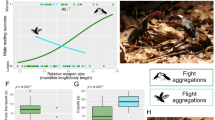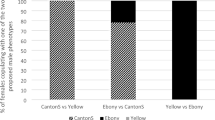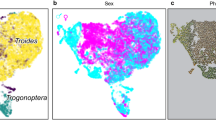Summary
The Arctic Skua is a seabird that is polymorphic for dark, intermediate and pale phenotypes of plumage. The melanic, dark and intermediate males can find mates sooner in the breeding season than the non-melanic, pale males. When males are looking for new mates, melanic males find mates on average four days sooner than non-melanic males. There is no difference in the breeding dates of the females, nor in the breeding dates of males who have not changed their mates. The difference in the males' breeding dates is found only on change of mate. Finding a new mate takes about six days for a dark male, about eight days for an intermediate male, and about eleven days for a pale male. These differences give the melanic males an advantage by sexual selection: exactly as Darwin had postulated in his theory of sexual selection of monogamous birds, the earlier pairs are more successful in terms of the numbers of chicks they rear to fledging. The overall disadvantage of intermediates and pales relative to darks is given by the sexual selective coefficients

The melanic males gain their advantage because the females prefer to mate with them. Models of female preference entail distributions of breeding dates that fit the data better than models of male competition. The earlier breeding of melanic males can be satisfactorily explained if 38 per cent of females prefer to mate with melanics rather than with non-melanics. In the model which fits the data best, 4 per cent of females prefer dark males and 34 per cent prefer either dark or intermediate males. Further evidence, which strongly supports the theory of female choice, is provided by the stability of the polymorphism, the existence of assortative mating, and the absence of any effect of male experience on the chances of finding a mate. The data of the Arctic Skua corroborate Darwin's theory of sexual selection by female choice in monogamous birds.
Similar content being viewed by others
Article PDF
References
Charlesworth, D, and Charlesworth, B. 1975. Sexual selection and polymorphism. Amer Natur, 109, 465–470.
Darwin, C R. 1871. The Descent of Man and Selection in Relation to Sex. John Murray, London.
Davis, J W F, and O'Donald, P. 1976a. Estimation of assortative mating preferences in the Arctic Skua. Heredity, 36, 235–244.
Davis, J W F, and O'Donald, P. 1976b. Territory size, breeding time and mating preference in the Arctic Skua. Nature, 260, 774–775.
Edwards, A W F. 1972. Likelihood. Cambridge University Press, Cambridge.
Ehrman, L, and Spiess, E B. 1969. Rare type mating advantage in Drosophila. Amer Natur, 103, 675–680.
O'Donald, P. 1972. Natural selection of reproductive rates and breeding times and its effect on sexual selection. Amer Natur, 106, 368–379.
O'Donald, P. 1974. Polymorphisms maintained by sexual selection in monogamous species of birds. Heredity, 32, 1–10.
O'Donald, P. 1976. Mating preferences and their genetic effects in models of sexual selection for colour phases of the Arctic Skua. Population Genetics and Ecology, ed. S. Karlin and E. Nevo, pp. 411–430. Academic Press, New York.
O'Donald, P. 1977a. Theoretical aspects of sexual selection. Theor Pop Biol, 12, 298–334.
O'Donald, P. 1977b. Mating preferences and sexual selection in the Arctic Skua. II. Behavioural mechanisms of the mating preferences. Heredity, 39, 111–119.
O'Donald, P. 1978a. Theoretical aspects of sexual selection: a generalized model of mating behaviour. Theor Pop Biol, 13, 226–243.
O'Donald, P. 1978b. Rare male mating advantage. Nature, 272, 189.
O'Donald, P. 1979. Theoretical aspects of sexual selection: variation in threshold of female mating response. Theor Pop Biol, 15, 191–204.
O'Donald, P. 1980a. Genetic Models of Sexual Selection. Cambridge University Press, Cambridge.
O'Donald, P. 1980b. Genetic models of sexual and natural selection in monogamous organisms. Heredity, 44, 391–415.
O'Donald, P, and Davis, J W F. 1975. Demography and selection in a population of Arctic Skuas. Heredity, 35, 75–83.
O'Donald, P, and Davis, J W F. 1977. Mating preferences and sexual selection in the Arctic Skua. III. Estimation of parameters and tests of heterogeneity. Heredity, 39, 121–132.
O'Donald, P, Wedd, N S, and Davis, J W F. 1974. Mating preferences and sexual selection in the Arctic Skua. Heredity, 33, 1–16.
Spiess, E B, and Ehrman, L. 1978. Rare male mating advantage. Nature, 272, 188–189.
Author information
Authors and Affiliations
Rights and permissions
About this article
Cite this article
O'Donald, P. Sexual selection by female choice in a monogamous bird: Darwin's theory corroborated. Heredity 45, 201–217 (1980). https://doi.org/10.1038/hdy.1980.61
Received:
Issue date:
DOI: https://doi.org/10.1038/hdy.1980.61
This article is cited by
-
Phenotypic assortative mating and genetic population structure in the crab Trapezia digitalis
Marine Biology (1987)
-
Female choice contributes to offspring fitness in the field cricket, Gryllus bimaculatus (De Geer)
Behavioral Ecology and Sociobiology (1987)



